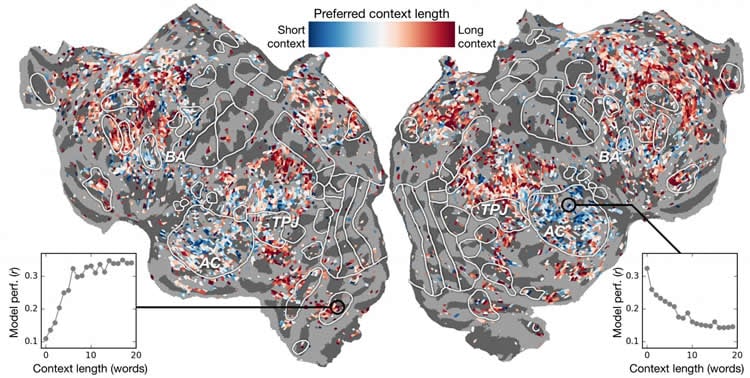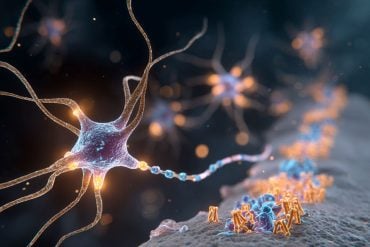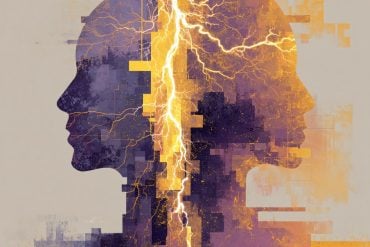Summary: A new deep learning system is able to predict, with great accuracy, how different brain areas respond to specific words. The model also found concepts localized to the auditory cortex are less dependent on context.
Source: UT Austin, Texas Advanced Computing Center
Can artificial intelligence (AI) help us understand how the brain understands language? Can neuroscience help us understand why AI and neural networks are effective at predicting human perception?
Research from Alexander Huth and Shailee Jain from The University of Texas at Austin (UT Austin) suggests both are possible.
In a paper presented at the 2018 Conference on Neural Information Processing Systems (NeurIPS), the scholars described the results of experiments that used artificial neural networks to predict with greater accuracy than ever before how different areas in the brain respond to specific words.
“As words come into our heads, we form ideas of what someone is saying to us, and we want to understand how that comes to us inside the brain,” said Huth, assistant professor of Neuroscience and Computer Science at UT Austin. “It seems like there should be systems to it, but practically, that’s just not how language works. Like anything in biology, it’s very hard to reduce down to a simple set of equations.”
The work employed a type of recurrent neural network called long short-term memory (LSTM) that includes in its calculations the relationships of each word to what came before to better preserve context.
“If a word has multiple meanings, you infer the meaning of that word for that particular sentence depending on what was said earlier,” said Jain, a PhD student in Huth’s lab at UT Austin. “Our hypothesis is that this would lead to better predictions of brain activity because the brain cares about context.”
It sounds obvious, but for decades neuroscience experiments considered the response of the brain to individual words without a sense of their connection to chains of words or sentences. (Huth describes the importance of doing “real-world neuroscience” in a March 2019 paper in the Journal of Cognitive Neuroscience.)
In their work, the researchers ran experiments to test, and ultimately predict, how different areas in the brain would respond when listening to stories (specifically, the Moth Radio Hour). They used data collected from fMRI (functional magnetic resonance imaging) machines that capture changes in the blood oxygenation level in the brain based on how active groups of neurons are. This serves as a correspondent for where language concepts are “represented” in the brain.
Using powerful supercomputers at the Texas Advanced Computing Center (TACC), they trained a language model using the LSTM method so it could effectively predict what word would come next – a task akin to Google auto-complete searches, which the human mind is particularly adept at.
“In trying to predict the next word, this model has to implicitly learn all this other stuff about how language works,” said Huth, “like which words tend to follow other words, without ever actually accessing the brain or any data about the brain.”
Based on both the language model and fMRI data, they trained a system that could predict how the brain would respond when it hears each word in a new story for the first time.
Past efforts had shown that it is possible to localize language responses in the brain effectively. However, the new research showed that adding the contextual element – in this case, up to 20 words that came before – improved brain activity predictions significantly. They found that their predictions improve even when the least amount of context was used. The more context provided, the better the accuracy of their predictions.
“Our analysis showed that if the LSTM incorporates more words, then it gets better at predicting the next word,” said Jain, “which means that it must be including information from all the words in the past.”
The research went further. It explored which parts of the brain were more sensitive to the amount of context included. They found, for instance, that concepts that seem to be localized to the auditory cortex were less dependent on context.
“If you hear the word dog, this area doesn’t care what the 10 words were before that, it’s just going to respond to the sound of the word dog”, Huth explained.
On the other hand, brain areas that deal with higher-level thinking were easier to pinpoint when more context was included. This supports theories of mind and language comprehension.
“There was a really nice correspondence between the hierarchy of the artificial network and the hierarchy of the brain, which we found interesting,” Huth said.
Natural language processing — or NLP — has taken great strides in recent years. But when it comes to answering questions, having natural conversations, or analyzing the sentiments in written texts, NLP still has a long way to go. The researchers believe their LSTM-developed language model can help in these areas.
The LSTM (and neural networks in general) works by assigning values in high-dimensional space to individual components (here, words) so that each component can be defined by its thousands of disparate relationships to many other things.
The researchers trained the language model by feeding it tens of millions of words drawn from Reddit posts. Their system then made predictions for how thousands of voxels (three-dimensional pixels) in the brains of six subjects would respond to a second set of stories that neither the model nor the individuals had heard before. Because they were interested in the effects of context length and the effect of individual layers in the neural network, they essentially tested 60 different factors (20 lengths of context retention and three different layer dimensions) for each subject.
All of this leads to computational problems of enormous scale, requiring massive amounts of computing power, memory, storage, and data retrieval. TACC’s resources were well suited to the problem. The researchers used the Maverick supercomputer, which contains both GPUs and CPUs for the computing tasks, and Corral, a storage and data management resource, to preserve and distribute the data. By parallelizing the problem across many processors, they were able to run the computational experiment in weeks rather than years.
“To develop these models effectively, you need a lot of training data,” Huth said. “That means you have to pass through your entire dataset every time you want to update the weights. And that’s inherently very slow if you don’t use parallel resources like those at TACC.”
If it sounds complex, well — it is.
This is leading Huth and Jain to consider a more streamlined version of the system, where instead of developing a language prediction model and then applying it to the brain, they develop a model that directly predicts brain response. They call this an end-to-end system and it’s where Huth and Jain hope to go in their future research. Such a model would improve its performance directly on brain responses. A wrong prediction of brain activity would feedback into the model and spur improvements.

“If this works, then it’s possible that this network could learn to read text or intake language similarly to how our brains do,” Huth said. “Imagine Google Translate, but it understands what you’re saying, instead of just learning a set of rules.”
With such a system in place, Huth believes it is only a matter of time until a mind-reading system that can translate brain activity into language is feasible. In the meantime, they are gaining insights into both neuroscience and artificial intelligence from their experiments.
“The brain is a very effective computation machine and the aim of artificial intelligence is to build machines that are really good at all the tasks a brain can do,” Jain said. “But, we don’t understand a lot about the brain. So, we try to use artificial intelligence to first question how the brain works, and then, based on the insights we gain through this method of interrogation, and through theoretical neuroscience, we use those results to develop better Artificial Intelligence.
“The idea is to understand cognitive systems, both biological and artificial, and to use them in tandem to understand and build better machines.”
Source:
UT Austin, Texas Advanced Computing Center
Media Contacts:
Aaron Dubrow – UT Austin, Texas Advanced Computing Center
Image Source:
The image is credited to Huth lab, UT Austin.
Original Research: Closed access
“Are We Ready for Real-world Neuroscience?”
Pawel J. Matusz, Suzanne Dikker, Alexander G. Huth, and Catherine Perrodin. Journal of Cognitive Neuroscience 2019 31:3, 327-338 doi:10.1162/jocn_e_01276
Abstract
Are We Ready for Real-world Neuroscience?
Real-world environments are typically dynamic, complex, and multisensory in nature and require the support of top–down attention and memory mechanisms for us to be able to drive a car, make a shopping list, or pour a cup of coffee. Fundamental principles of perception and functional brain organization have been established by research utilizing well-controlled but simplified paradigms with basic stimuli. The last 30 years ushered a revolution in computational power, brain mapping, and signal processing techniques. Drawing on those theoretical and methodological advances, over the years, research has departed more and more from traditional, rigorous, and well-understood paradigms to directly investigate cognitive functions and their underlying brain mechanisms in real-world environments. These investigations typically address the role of one or, more recently, multiple attributes of real-world environments. Fundamental assumptions about perception, attention, or brain functional organization have been challenged—by studies adapting the traditional paradigms to emulate, for example, the multisensory nature or varying relevance of stimulation or dynamically changing task demands. Here, we present the state of the field within the emerging heterogeneous domain of real-world neuroscience. To be precise, the aim of this Special Focus is to bring together a variety of the emerging “real-world neuroscientific” approaches. These approaches differ in their principal aims, assumptions, or even definitions of “real-world neuroscience” research. Here, we showcase the commonalities and distinctive features of the different “real-world neuroscience” approaches. To do so, four early-career researchers and the speakers of the Cognitive Neuroscience Society 2017 Meeting symposium under the same title answer questions pertaining to the added value of such approaches in bringing us closer to accurate models of functional brain organization and cognitive functions.






